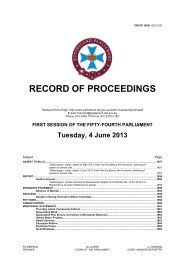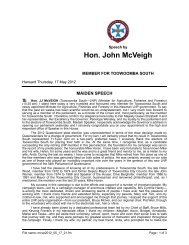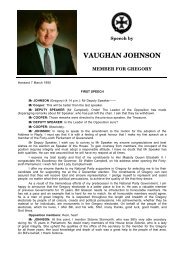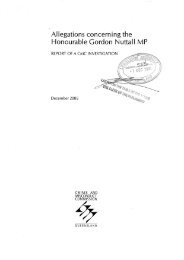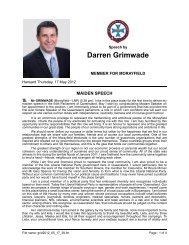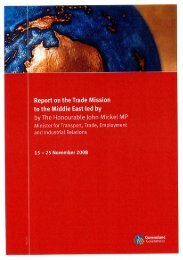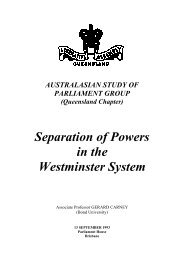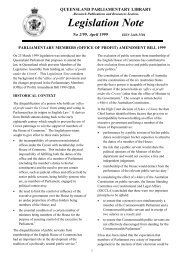CQUniversity Annual Report - Central Queensland University
CQUniversity Annual Report - Central Queensland University
CQUniversity Annual Report - Central Queensland University
You also want an ePaper? Increase the reach of your titles
YUMPU automatically turns print PDFs into web optimized ePapers that Google loves.
<strong>CQ<strong>University</strong></strong> ANNUAL REPORT 2012<br />
<strong>Central</strong> <strong>Queensland</strong> <strong>University</strong><br />
and Controlled Entities<br />
Notes to the Financial Statements<br />
for the year ended 31 December 2012<br />
Acquisition of assets with a cost or other value equal to or in excess of the following thresholds are recognised for financial<br />
reporting purposes in the year of acquisition:<br />
Buildings $10,000<br />
Infrastructure $10,000<br />
Land $1<br />
Plant and equipment $5,000<br />
Shares $1<br />
Computer software $100,000<br />
Goodwill $1<br />
Other (including artworks and heritage) $1<br />
Where settlement of any part of cash consideration is deferred, the amounts payable in the future are discounted to their<br />
present value as at the date of exchange. The discount rate used is the entity’s incremental borrowing rate, being the rate<br />
at which a similar borrowing could be obtained from an independent financier under comparable terms and conditions.<br />
15<br />
ANNUAL FINANCIAL STATEMENTS<br />
(h)<br />
Impairment of assets<br />
The carrying amounts of the consolidated entity’s assets, other than inventories and deferred tax assets are assessed on<br />
an annual basis to determine whether there is any indication of impairment. If any such indication exists, the asset’s<br />
recoverable amount is estimated.<br />
Goodwill and intangible assets that have an indefinite useful life are not subject to amortisation and are tested annually for<br />
impairment or more frequently if events or changes in circumstances indicate that they might be impaired. Other assets are<br />
reviewed for impairment whenever events or changes in circumstances indicate that the carrying amount may not be<br />
recoverable. An impairment loss is recognised for the amount by which the asset’s carrying amount exceeds its<br />
recoverable amount. The recoverable amount is the higher of an asset’s fair value less costs to sell and value in use. For<br />
the purposes of assessing impairment, assets are grouped at the lowest levels for which there are separately identifiable<br />
cash flows which are largely independent of the cash inflows from other assets or groups of assets (cash generating units).<br />
Non-financial assets other than goodwill that suffered impairment are reviewed for possible reversal of the impairment at<br />
each reporting date.<br />
(i)<br />
Cash and cash equivalents<br />
Cash and cash equivalents include cash on hand, deposits held at call with financial institutions, other short-term, highly<br />
liquid investments with original maturities of three months or less that are readily convertible to known amounts of cash and<br />
which are subject to an insignificant risk of changes in value.<br />
(j)<br />
Receivables<br />
Commercial and general debtors are recognised at cost less impairment losses and are generally due for settlement<br />
within 14 days.<br />
Student debtors are recognised at cost and are due within 14 days of invoice.<br />
Collectability of trade receivables are reviewed on an on-going basis. An allowance for impaired receivables is established<br />
when there is objective evidence that the Group may not be able to collect certain debts. Debts which are known to be<br />
uncollectible, when formally approved for write off, are written off against the allowance for impaired receivables to the<br />
extent that the expense has previously been provided for. Receivables expected to be received in the next 12 months are<br />
classified as current.<br />
(k)<br />
Inventories<br />
Inventories are stated at the lower of cost or net realisable value which is the estimated selling price in the ordinary course<br />
of business less the estimated costs of completion and the estimated costs necessary to make the sale.<br />
The cost of inventories comprises all costs of purchases and other costs of bringing the inventories to their present location<br />
and condition. Bookshop inventory cost is determined using the weighted average cost method.<br />
Obsolete, redundant and slow moving inventories are identified and written down to their estimated current replacement<br />
cost.



